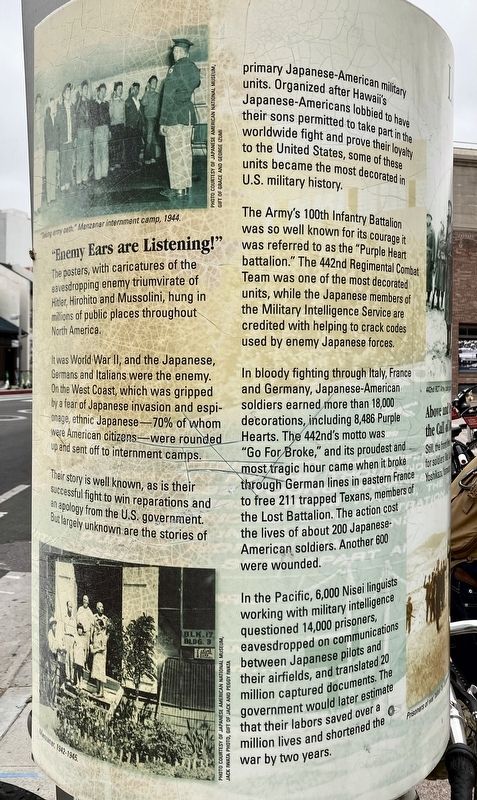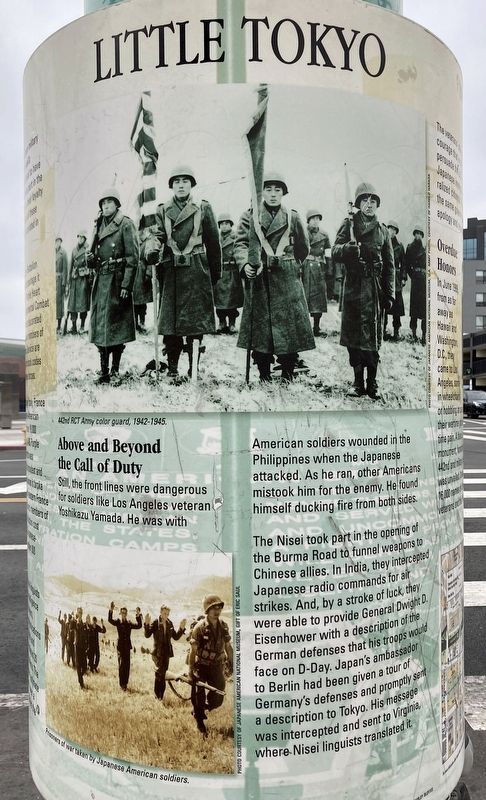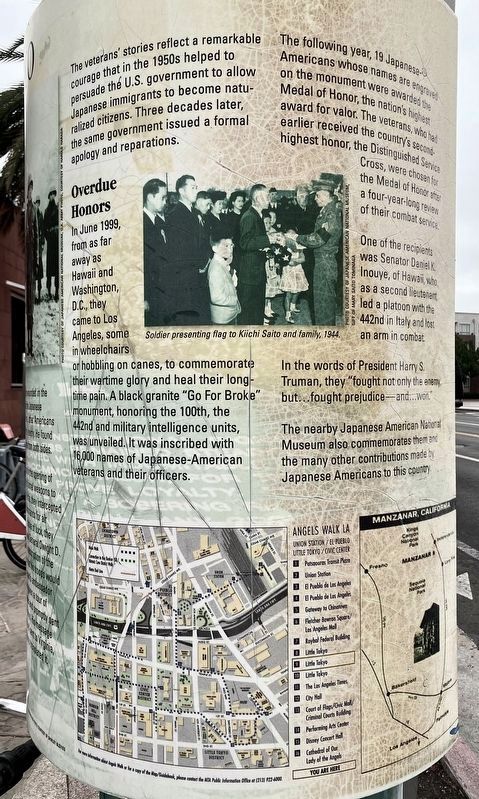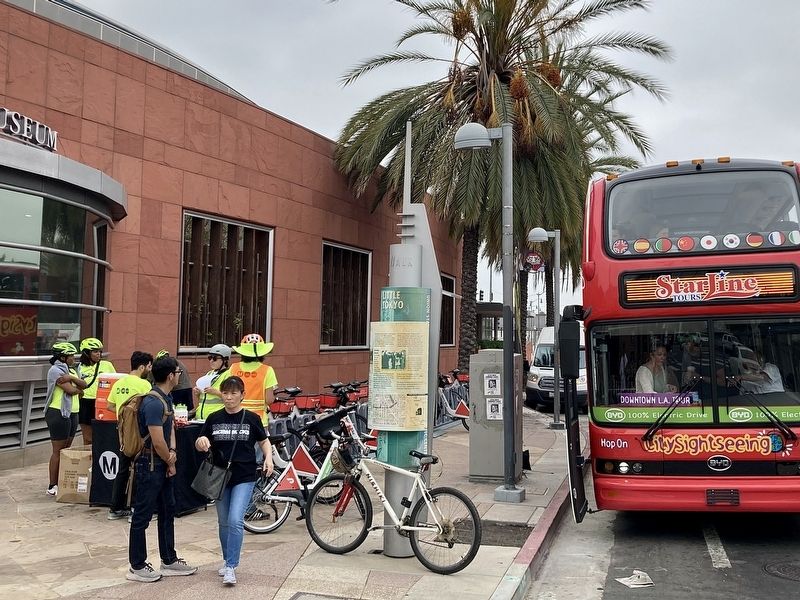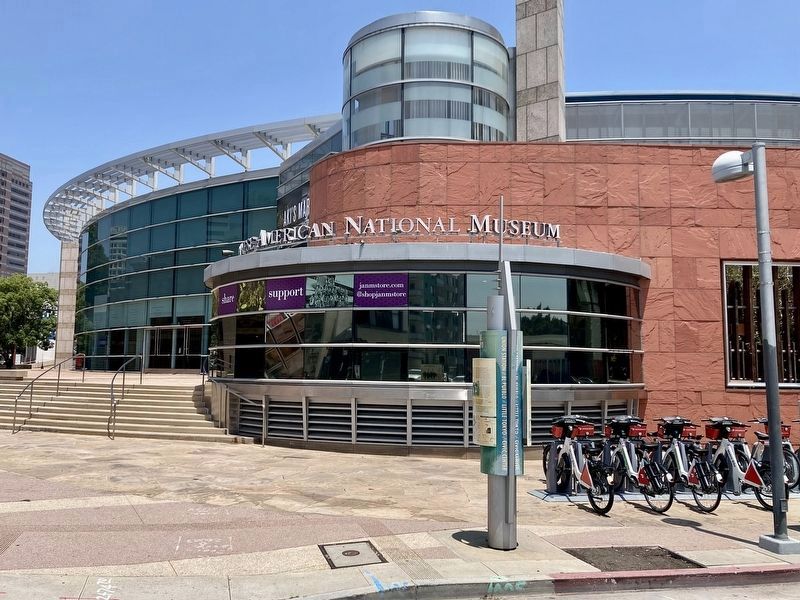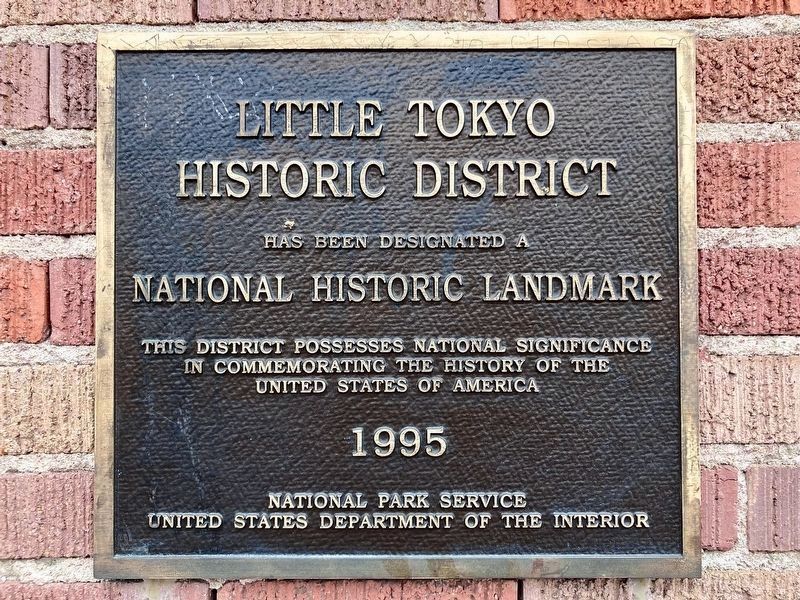Downtown Los Angeles in Los Angeles County, California — The American West (Pacific Coastal)
Little Tokyo
"Enemy Ears are Listening!"
The posters, with caricatures of the eavesdropping enemy triumvirate of Hitler, Hirohito and Mussolini, hung in millions of public places throughout North America.
It was World War II, and the Japanese, Germans and Italians were the enemy. On the West Coast, which was gripped by a fear of Japanese invasion and espionage, ethnic Japanese — 70% of whom were American citizens — were rounde up and sent off to internment camps.
Their story is well known, as is their successful fight to win reparations and an apology from the U.S. government. But largely unknown are the stories of primary Japanese-American military units. Organized after Hawaii's Japanese-Americans lobbied to have their sons permitted to take part in the worldwide fight and prove their loyalty to the United States, some of these units became the most decorated in U.S. military history.
The Army's 100th Infantry Battalion was so well known for its courage it was referred to as the "Purple Heart battalion." The 442nd Regimental Combat Team was one of the most decorated units, while the Japanese members of the Military Intelligence Service are credited with helping to crack codes used by enemy Japanese forces.
In bloody fighting through Italy, France and Germany, Japanese-American soldiers earned more than 18,000 decorations, including 8,486 Purple Hearts. The 442nd's motto was "Go For Broke," and its proudest and most tragic hour came when it broke through German lines in eastern France to free 211 trapped Texans, members of the Lost Battalion. The action cost the lives of about 200 Japanese-American soldiers. Another 600 were wounded.
In the Pacific, 6,000 Nisei linguists working with military intelligence questioned 14,000 prisoners, eavesdropped on communications between Japanese pilots and their airfields, and translated 20 million captured documents. The government would later estimate that their labors saved over a million lives and shortened the war by two years.
Above and Beyond the Call of Duty
Still, the front lines were dangerous for soldiers like Los Angeles veteran Yoshikazu Yamada. He was with American soldiers wounded in the Philippines when the Japanese attacked. As he ran, other Americans mistook him for the enemy. He found himself ducking fire from both sides. The Nisei took part in the opening of the Burma Road to funnel weapons to Chinese allies. In India, they intercepted Japanese radio commands for air strikes. And, by a stroke of luck, they were able to provide General Dwight D. Eisenhower with a description of the German defenses that his troops would face on D-Day. Japan's ambassador to Berlin had been given a tour of Germany's defenses and promptly sent a description to Tokyo. His message was intercepted and sent to Virginia, where Nisei linguists translated it.
The veterans' stories reflect a remarkable courage that in the 1950s helped to persuade the U.S. government to allow Japanese immigrants to become naturalized citizens. Three decades later, the same government issued a formal apology and reparations.
Overdue Honors
In June 1999, from as far away as Hawaii and Washington, D.C., they came to Los Angeles, some in wheelchairs or hobbling on canes, to commemorate their wartime glory and heal their long time pain. A black granite "Go For Broke" monument, honoring the 100th, the 442nd, and military intelligence units was unveiled. It was inscribed with 16,000 names of Japanese-American veterans and their officers.
The following year, 19 Japanese-Americans whose names are engraved on the monument were awarded the Medal of Honor, the nation's highest award for valor. The veterans, who had earlier received the country's second-highest honor, the Distinguished Service Cross, were chosen for the Medal of Honor after a four-year-long review of their combat service.
One of the recipients was Senator Daniel K. Inouye, of Hawaii, who, as a second lieutenant, led a platoon with the 442nd in Italy and lost an arm in combat.
In the words of President Harry S. Truman, they "fought not only the enemy but...fought prejudice — and won."
The nearby Japanese American National Museum also commemorates them and the many other contributions made by Japanese Americans to this country.
Erected 2000 by City of Los Angeles.
Topics. This historical marker is listed in these topic lists: Asian Americans • Settlements & Settlers. A significant historical year for this entry is 1944.
Location. 34° 2.956′ N, 118° 14.336′ W. Marker is in Los Angeles, California, in Los Angeles County. It is in Downtown Los Angeles. Marker is on 1st Street west of Alameda Street, on the right when traveling west. Touch for map. Touch for directions.
Other nearby markers. At least 8 other markers are within walking distance of this marker. Hompa Hongwanji Buddhist Temple (within shouting distance of this marker); Home Is Little Tokyo Mural (within shouting distance of this marker); History Mural - Little Tokyo (within shouting distance of this marker); Atomic Cafe (within shouting distance of this marker); Honor Award Story (within shouting distance of this marker); Aoyama Tree (about 300 feet away, measured in a direct line); Sei Fujii (about 500 feet away); Fugetsu-Do (about 600 feet away). Touch for a list and map of all markers in Los Angeles.
Also see . . . Angels Walk L.A. Self-guided walking tours of historic neighborhoods in Los Angeles. The Little Tokyo marker is part of the Union Station walk. (Submitted on July 11, 2023.)
Credits. This page was last revised on July 11, 2023. It was originally submitted on July 11, 2023, by Craig Baker of Sylmar, California. This page has been viewed 78 times since then and 20 times this year. Photos: 1, 2, 3, 4, 5, 6. submitted on July 11, 2023, by Craig Baker of Sylmar, California.
